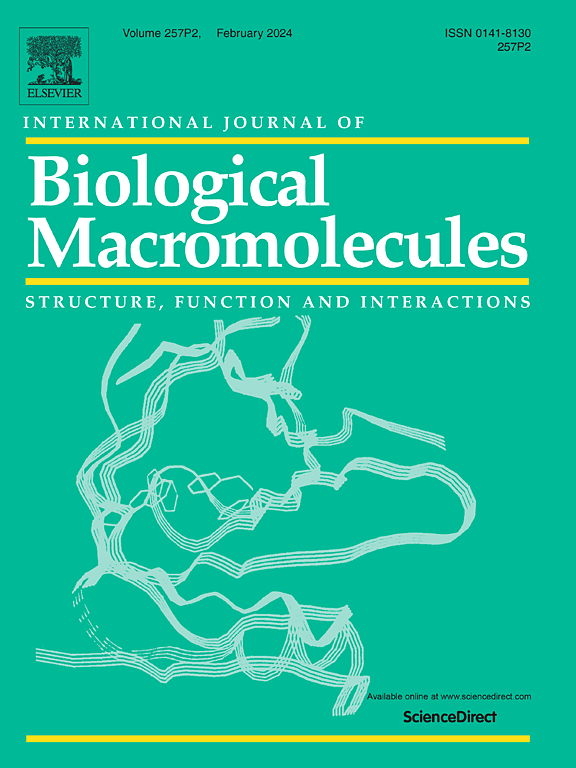Identification of three novel B cell epitopes targeting the bovine viral diarrhea virus NS3 protein for use in diagnostics and vaccine development
IF 7.7
1区 化学
Q1 BIOCHEMISTRY & MOLECULAR BIOLOGY
International Journal of Biological Macromolecules
Pub Date : 2025-04-01
DOI:10.1016/j.ijbiomac.2025.142767
引用次数: 0
Abstract
Bovine viral diarrhea virus (BVDV) is a major pathogen in cattle herds, widely distributed across the globe and causing significant economic losses to the cattle industry. The nonstructural protein NS3 is highly conserved across BVDV subtypes. Identifying and screening epitopes on BVDV NS3 is crucial for developing sensitive, specific diagnostic tools. In this study, we obtained three monoclonal antibodies (mAbs) against the NS3 protein: 2F7, 3E8, and 4D6. Three novel linear B-cell epitope 100EYG102, 384FLDIA388, and 100EYGVK104 were identified through reactions of these mAbs with a series of continuous-truncated peptides and one of which a rare three-amino-acid B-cell epitope 100EYG102. Critical amino acid residues were further characterized through alanine (A)-scanning mutagenesis. Sequence alignment revealed that 100EYG102 and 100EYGVK104 were highly conserved allowing mAbs 2F7 and 4D6 to recognize all BVDV subtypes. In contrast, 384FLDIA388 was specifically conserved in BVDV-1 and BVDV-3 enabling 3E8 mAb to differential diagnosis BVDV-2 from other BVDV subtypes. Additionally, preliminary diagnostic assays for BVDV were established by western blotting and peptide-based blocking ELISA. Moreover, we observed that these mAbs could inhibit the replication of BVDV. These findings provide a theoretical foundation for developing of therapeutic strategies for nonstructural protein and accurate diagnostic procedures.
牛病毒性腹泻病毒(BVDV)是牛群中的主要病原体,广泛分布于全球各地,给养牛业造成了巨大的经济损失。非结构蛋白 NS3 在 BVDV 亚型中高度保守。鉴定和筛选 BVDV NS3 上的表位对于开发灵敏、特异的诊断工具至关重要。在这项研究中,我们获得了三种针对 NS3 蛋白的单克隆抗体(mAbs):2F7、3E8 和 4D6。通过这些 mAbs 与一系列连续截短的肽和其中一个罕见的三氨基酸 B 细胞表位 100EYG102 反应,确定了三个新的线性 B 细胞表位 100EYG102、384FLDIA388 和 100EYGVK104。通过丙氨酸(A)扫描诱变进一步确定了关键氨基酸残基的特征。序列比对显示,100EYG102 和 100EYGVK104 高度保守,使得 mAbs 2F7 和 4D6 能够识别所有 BVDV 亚型。相比之下,384FLDIA388在BVDV-1和BVDV-3中具有特异性保守性,使3E8 mAb能够将BVDV-2与其他BVDV亚型进行鉴别诊断。此外,我们还通过 Western 印迹和基于肽的阻断 ELISA 建立了 BVDV 的初步诊断方法。此外,我们还观察到这些 mAbs 可以抑制 BVDV 的复制。这些发现为开发非结构蛋白治疗策略和准确诊断程序提供了理论基础。
本文章由计算机程序翻译,如有差异,请以英文原文为准。
求助全文
约1分钟内获得全文
求助全文
来源期刊
CiteScore
13.70
自引率
9.80%
发文量
2728
审稿时长
64 days
期刊介绍:
The International Journal of Biological Macromolecules is a well-established international journal dedicated to research on the chemical and biological aspects of natural macromolecules. Focusing on proteins, macromolecular carbohydrates, glycoproteins, proteoglycans, lignins, biological poly-acids, and nucleic acids, the journal presents the latest findings in molecular structure, properties, biological activities, interactions, modifications, and functional properties. Papers must offer new and novel insights, encompassing related model systems, structural conformational studies, theoretical developments, and analytical techniques. Each paper is required to primarily focus on at least one named biological macromolecule, reflected in the title, abstract, and text.

 求助内容:
求助内容: 应助结果提醒方式:
应助结果提醒方式:


